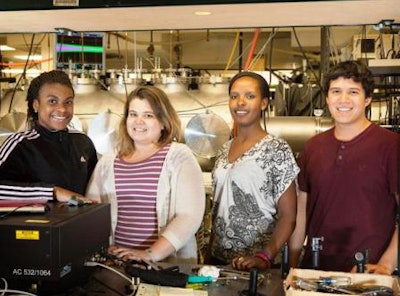 The Virginia-North Carolina Alliance supports minority students in STEM.
The Virginia-North Carolina Alliance supports minority students in STEM.A growing number of colleges and universities are gaining an edge on recruiting and retaining more minority students in science, technology, engineering and mathematics by forming cross-campus partnerships.
Through these partnerships, public, private and historically Black colleges exchange resources and best practices to implement programs focused on student support, academic enrichment and research skill development. Such alliances also allow schools to pursue grant money toward increasing enrollment among underrepresented groups. Recently, the Virginia-North Carolina Alliance for Minority Participation received a second, five-year grant from the National Science Foundation to assist minority students in STEM. With the additional infusion of $3.5 million, the Alliance can augment its summer transition programs, peer mentoring, academic monitoring, workshops, summer research experiences, living learning community and field trips.
“Program activities are as influential to students as their parents because your peer network becomes your support network,” said Rosalyn Hobson Hargraves, institutional project director at Virginia Commonwealth University in Richmond, Va., a member of the Virginia-North Carolina Alliance.
Other members of the alliance include Bennett College for Women in Greensboro, N.C.; Elizabeth City State University in Elizabeth City, N.C.; George Mason University in Fairfax, Va.; Johnson C. Smith University in Charlotte, N.C.; Piedmont Virginia Community College in Charlottesville, Va.; St. Augustine’s University in Raleigh, N.C.; University of Virginia in Charlottesville, Va.; and Virginia Polytechnic Institute and State University in Blacksburg, Va.
Under the grant renewal, the Alliance plans to add Piedmont Virginia Community College in Charlottesville.
Though effective alone, the social and community services offered to students tend to yield greater efficacy when provided through the collaboration. Such collectives have helped increase minority enrollment in STEM majors from 35,670 in 1991 to more than 225,000 in 2013, according to the National Science Foundation. STEM enrollment among all Virginia-North Carolina Alliance institutions has increased 39 percent from 3,500 students in 2007 to nearly 5,000 minority students in 2012, according to the Alliance.
The Alliance has also set a goal to increase STEM minority enrollment and graduation rates by 60 percent through 2017. So far, STEM graduation rates among minorities have grown by 67 percent from 488 to 3,101 between 2007 and 2012 at Alliance schools.
The Virginia-North Carolina Alliance is one of 41 national alliances representing 600 institutions and funded by the Louis Stokes Alliance for Minority Participation (LSAMP), a program of NSF. LSAMP awards grants of $300,000 to $1 million to city, state or cross-state partnerships between two- and four-year institutions to increase the number of underrepresented minorities graduating with baccalaureate STEM degrees. Select students receive a stipend for participating in LSAMP-sponsored activities.
“We cannot afford to ignore the potential bright students based on some racial, ethnicity or gender definitions,” said A. James Hicks, LSAMP program director. “We don’t care who discovers the next big breakthrough in cancer research or where the next Nobel Prize Laureate comes from, but we would certainly be disappointed if we didn’t let a student be the best that he or she can be.”
The program not only increases the quantity of students entering the STEM discipline, but it also increases their academic achievement. About 80 percent of LSAMP students took additional coursework after obtaining a bachelor’s degree, compared to 60 percent for non-LSAMP graduates, Whites and Asians, according to a 2006 report by the Urban Institute titled “Revitalizing the Nation’s Talent Pool in STEM.” Sixty-six percent pursued graduate degrees, compared to 45 percent non-LSAMP, and 45 percent obtained graduate degrees compared to 20 percent non-LSAMP.
Likewise, participating institutions report positive outcomes overall, according to the Urban Institute report. Institutions with alliances tend to show an increase in performance among all STEM students.
“In spite of us being a targeted program, we’ve found that all the boats are rising now,” said Hicks, a former dean at North Carolina A&T. “The good practices and good learnings tend to improve learnings for all students; it’s causing quality to go up and greater learning to go up.”
Since its inception in 1991 as the Alliance for Minority Participation (later renamed in honor of champion educator Congressman Louis Stokes), the LSAMP program has expanded its services despite stagnated federal funding. In 2005, it increased efforts to increase research opportunities for Native American and Pacific Islander students. Earlier this year, the Bridge to Baccalaureate focus was added to transition students in STEM disciplines from two-year to four-year institutions.
In the next month, LSAMP will add two more states to its program participants toward significantly increasing the number of institutions and regions represented. It also aims to expand international research opportunities for students.



















